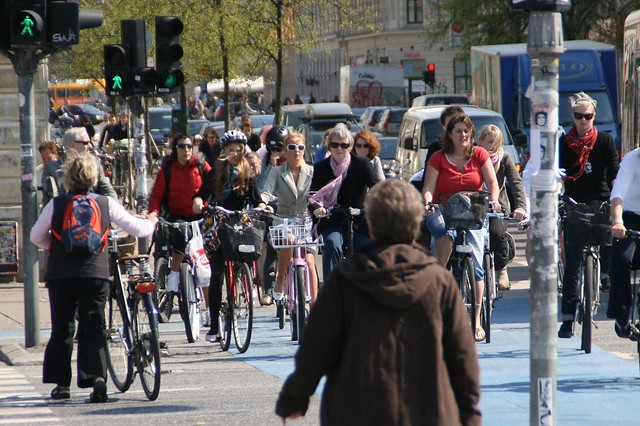

This post is by one of Copenhagenize's finest, Rachel. She's been involved in quite a few of our projects, including the next Copenhagenize Index for bicycle-friendly cities.
By now we all know (or have at least heard) that cycling is beneficial for cities, and the benefits range from improving health to decreasing congestion. For those who aren’t on board yet, some of the findings we developed here at Copenhagenize should help change your mind.
We can talk on and on about the various benefits that come with bikes, but when it comes to municipalities actually implementing policies and infrastructure, the conversation will inevitably turn to numbers. How do the real costs of driving a car compare with the costs of riding a bike? We believe we have developed a comprehensive cost analysis to properly compare these modes of transport.
With Christine Grant spearheading this effort, we were able to come up with a cost analysis that incorporated typical factors such as travel time, vehicle and road maintenance, health, and carbon emissions. However, we also made sure to include several other factors that would represent the real costs of driving and cycling rather than just the face value costs we often encounter that only account for gas prices and carbon emissions. These factors include noise pollution, the impact of oil leaking from vehicles on water quality, parking and a city’s branding/tourism.
Population, modal share, average household income, and the cost of a gallon of gasoline are city-specific values that can easily be changed for each city, but in order to provide a concrete example, we looked at numbers for Christine’s hometown – Seattle, Washington.
Basic Stats :
Population: 563,374
Average Household Income: $45,736
Cost of 1 Gallon of Gasoline: $4.15
Total Trips (all modes) Annually: 5.9 million
Modal Share :
Bicycle: 2%
Pedestrian: 7%
Public Transit: 18%
Car: 73%
For calculating the costs of maintaining and operating a car and a bicycle, we took not only internal but also external costs into consideration.
Internal costs include:
- Travel time
- Vehicle/bike usage (gas, tires, maintenance)
- Health
- Parking Fees
External costs include:
- Air, noise and stormwater (i.e. from oil runoff) pollution
- Road deterioration
- Parking Infrastructure
- Branding/tourism
- Climate change
- Congestion
Out of these costs, there were two particularly interesting comparisons. The internal time cost for cyclists is $0.33/km and $0.16/km for motorists, which is a $0.17 difference between the two. Based solely on these numbers, it seems like cyclists are paying twice the amount of motorists to get somewhere, but this is where a crucial cost comes in: maintenance and operation. Cyclists pay a meager $0.03/km but motorists are paying $0.71/km (hello, peak oil!). At this point, cyclists are paying $0.36/km and motorists are paying $0.87/km (a $0.51/km difference). The margin, however, gets even wider as we factor in all the external costs, and we conclude that cycling actually results in a profit of $0.46/km ($0.73/mi) whereas cars cost $1.13/km ($1.82/mi). The total cost difference is $1.59/km ($2.55/mi) between cars and bikes!
Now that the financial benefits of cycling over driving are clear, what would happen to a city if there were a modal shift of just 1% of drivers becoming cyclists? In order to have this modal shift, there would need to be approximately 8,300 drivers becoming cyclists to have a 50.5 million km decrease in Vehicle Kilometers Traveled (VKT) and a 32.4 million km increase in Bicycle Kilometers Traveled (BKT) per year.
So by this point, we’ve been crunching a lot of numbers and our brains are running at full speed and as a result, we’ve got some compelling figures to prove the bicycle victorious over the car once again. By shifting 1% of drivers to become cyclists, $57.2 million is saved from reducing the goal VKT and $14.7 million is profited by increasing the goal BKT for a total benefit of $71.9 million.
So there you go. Are you convinced?




